Cherson, ancient coins of
Coins of ancient Cherson are scarce and often in low grade. Here are several, one from the Greek period and six from the Roman period. The primary reference is Anokhin's book, The Coinage of Chersonesus, which is in Russian and has been translated into English by H. Bartlett Wells (BAR International Series 69, 1980). Five types are listed in Sear's Greek Coins and their Values, volume I, 1664-1668 on pages 165-166. SNG XI Stancomb and SNG IX British Museum, The Black Sea, also cover this region, but not nearly as thoroughly as Anokhin.
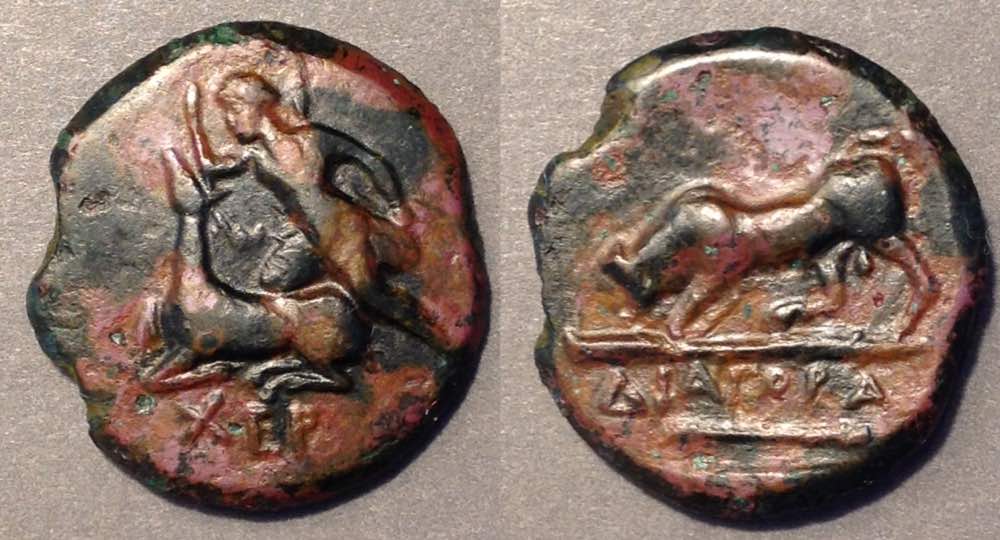
AE21. 12:00. 5.65 grams.
Artemis kneeling left on prostrate stag which she spears
XEP (the beginning of "Cherson" in Greek) below
/bull butting left with club and quiver beneath
ΔIAΓOPA below
late 4th - first half of 3rd C. B.C.
Anokhin 78.
Stancomb 474.
Sear Greek 1668 (no photo).
Cherson received "freedom" or "independence" under Antoninus Pius. After that, the city's coins often mention "freedom." However, the lack of an imperial name or any other identification of a date means they must be dated by other means. Anokhin seems to use the criterion that cruder is later (which seems justifed) but picks time spans of arbitrary length for each type. I am not at all convinced we know when the following types were issued.
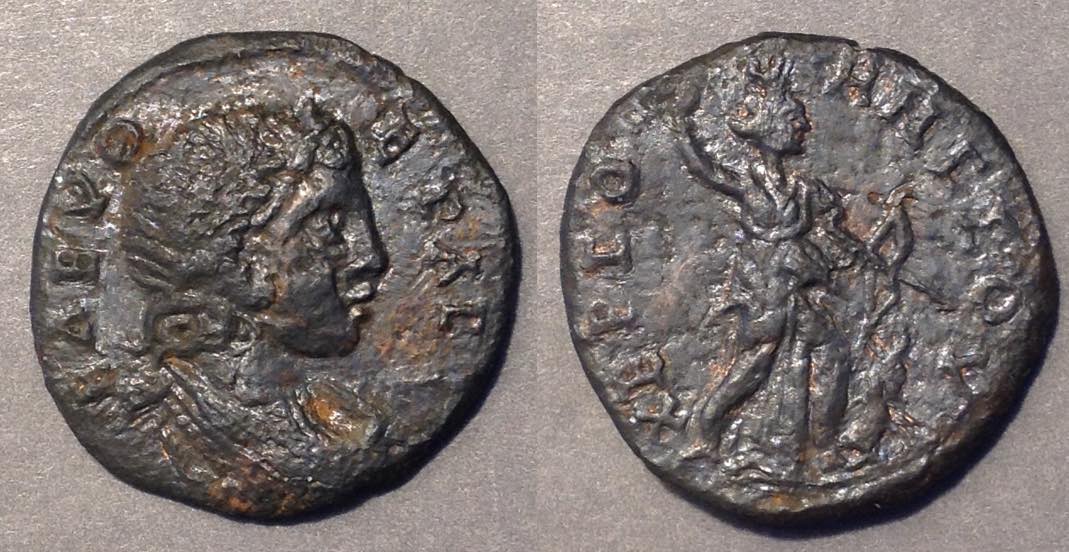 22 mm. 6:00. 5.24 grams.
22 mm. 6:00. 5.24 grams.
Female bust right, sometimes considered to be Julia Domna, wife of Septimius Severus. (See also the second-next coin.)
EΛPCO-HNCEOV [Eleutheria = "Freedom" in Greek]
/XEPCO-HNCEOV
Artemis advancing right with bow and arrow, right hand raised overhead, stag head below right
Anokhin 287 variety, with a significantly different portrait. 212-217 AD, regarded as an issue at the time of Julia Domna.
Stancomb --. Sear Greek --.
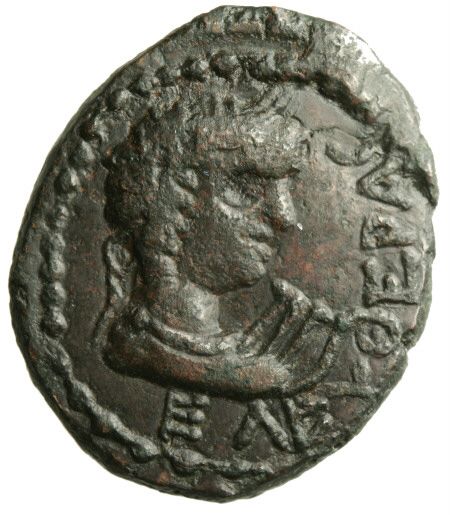
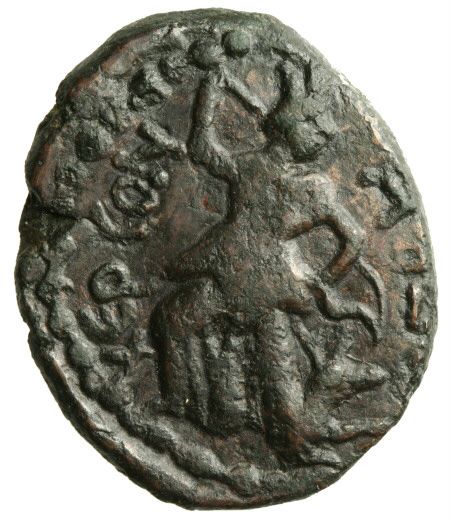 AE25-21. 7.92 grams. Extremely rare, especially in this condition. (It has been smoothed and corrosion cut off, but most are even further from original surfaces than this one. A remarkable coin "for type".)
AE25-21. 7.92 grams. Extremely rare, especially in this condition. (It has been smoothed and corrosion cut off, but most are even further from original surfaces than this one. A remarkable coin "for type".)
City of Cherson. Struck during an era of "Freedom," period of AD 145-268, the "second liberation".
EΛEVΘEPAC = "Freedom", in Greek. Laureate bust right, with lyre. BMC calls it Apollo.
XEPCON-HOCY
The Maiden (Artemis) moving left but facing right, with spear and bow, stag at her feet right.
Anokhin (Cherson) 302, attributed to 222-235, which would be the reign of Severus Alexander.
The arguments given by Anokhin to attribute it to this specific time period within the greater "freedom" period do not convince me.
SNG Stancomb --, but cf. 960 of "Elagabalus" with some similarities but different arrangement of the elements.
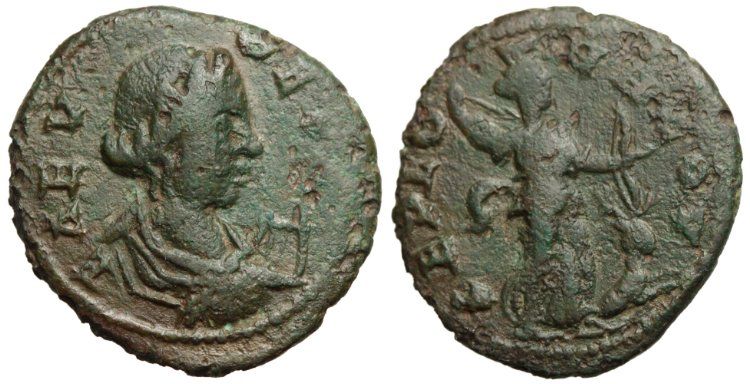 Cherson AE23-22. 7:00. 5.88 grams.
Cherson AE23-22. 7:00. 5.88 grams.
EΛPCΘ-HNCEOV [Eleutheria = "Freedom" in Greek] Laureate bust right, with lyre. BMC calls it Apollo.
XEPCON-HOCY
Anokhin thinks this might be Julia Domna, for reasons I think are weak. Therefore, he dates it to c.212-217 AD.
He sees another coin as possibly having the portrait of Caracalla as enough similar to this one that they should be from the same time period, and therefore this might be Julia Domna. But neither looks much like the supposed person, and the lyre makes it clear this is Apollo and not Julia Domna.
It must be struck, as the coin above, during the "Freedom," ("Independence") period of AD 145-268, the "second liberation". It is not the last type of the period, since the next coin is obviously later (because it is cruder and smaller). Being the about the last type, the second-next coin could be near the end of the period. That is why Anokhin gives it to Gallienus.
Anokhin 287, same dies.
SNG Stancomb -- but style close to 954 but with Artemis going the other way. Sear Greek --.

22-19 mm. 2:00. 5.21 grams. Possibly time of Caracalla.
Bull butting right. EΛEVΘ-EP AC in ex. [Eleutheria = "Freedom" in Greek]
XEPCON-H...
Anokhin 293 variety (293 is both lighter in weight and smaller in diameter, although it can be impossible to tell since Anokhin's images are not always life size. They are often somewhat larger than the coin. Since his image of 293 is significantly smaller than this coin, I conclude they are not the same denomination.)
BMC Thrace --, Stancomb --, SNG BM Black Sea --, SNG Pushkin --. Sear Greek --.

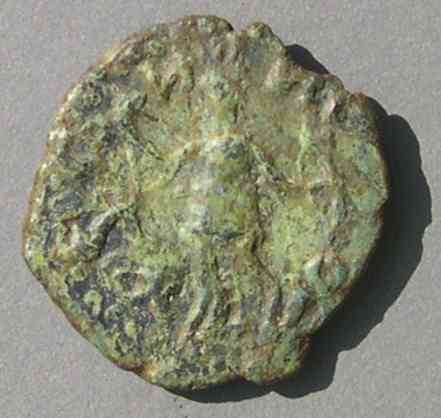
Cherson AE20. 1:00. 3.65 grams.
Bust as above, but much cruder and flan size smaller.
EΛEVΘ-HNCEOV [Eleutheria = "Freedom" in Greek]
Laureate bust right, with lyre. BMC calls it Apollo.
The second-previous reverse legend is XEPCON-HOCY and there are signs of it on this coin, but I could not read it if I didn't know what it was supposed to say.
Anokhin 306 (same dies), attributed to the period of Gallienus, 253-268 AD.
Stancomb 959 Variety. Sear Greek --.
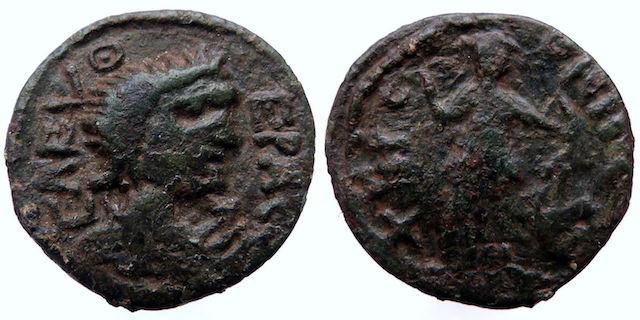
Cherson AE21. 12:00. 5.07 grams.
Crude bust right. EΛEVΘ EPAC ["independence"]
Artemis standing front, head right, bow in left arm right
XEPCON-H[OCY]
Anokhin 301 "222-235 AD"
SNG Stancomb --, SNS BM Black Sea --. Sear Greek --.
Anokin dates this "222-235 AD"
Return to the page on coins of Byzantine Cherson.




 Cherson AE23-22. 7:00. 5.88 grams.
Cherson AE23-22. 7:00. 5.88 grams.


